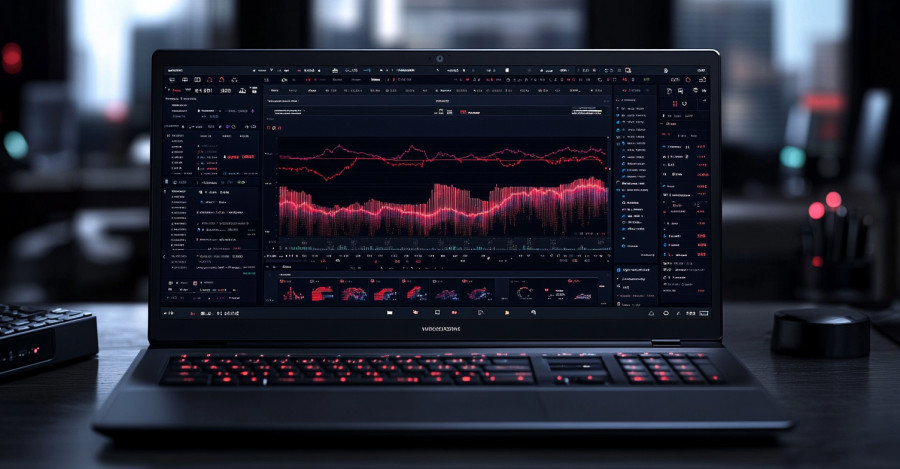Johnson & Johnson faced a serious setback when a judge rejected a $10 billion settlement over talc claims, causing the company's stock to plummet by 7.6%.
Market participants have to digest a series of economic data before Donald Trump's speech on tariffs. Investors are alert to his announcement as if waiting for an important premiere. Airline companies took a dive after analysts at Jefferies downgraded their ratings – and it seemed more like a crash than just a dip. Johnson & Johnson was also unlucky: a judge rejected the modest $10 billion settlement over the talc case, and the company's stock went downhill. Meanwhile, the US stock indices staged a true mixed parade: the Dow dipped by 0.03%, while the S&P 500 grew by 0.38%, and the Nasdaq surged by 0.87%.
Everyone is awaiting the moment when US President Donald Trump will finally reveal his tariff plans in the White House Rose Garden – on April 2, precisely at 4:00 PM Eastern Time. Investors are caught between hope and fear: there's a chance that new tariff surprises could slow the economy and ignite inflation. Even if Trump clarifies everything, he is unlikely to add much clarity to the markets: geopolitics, trade partners, and economic consequences still feel like reading tea leaves. More details here.
US stock indices closed mixed yesterday, with the S&P 500 rising by 0.38% and the Nasdaq by 0.87%, while the Dow slipped by 0.04%.
US benchmark stock indices staged a mixed performance yesterday: the S&P 500 rose by 0.38%, Nasdaq 100 added a robust 0.87%, but the Dow Jones seemed to take a pause, slightly declining by 0.04%.
Meanwhile, Asia woke up on a sour note: traders in the East took a defensive position in anticipation of Donald Trump's speech, during which he promised to present new reciprocal tariffs. Against this backdrop, the yield on 10-year US Treasury bonds rose for the first time in three days.
As European and US futures slid lower, the dollar remained flat, and gold hovered just below its historic peak, the entire world seemed to hold its breath. At 4:00 PM New York time, Trump is expected to announce his "liberating" tariffs, which he claims will take effect immediately. Chicago Federal Reserve President Austan Goolsbee has already gloomily warned of a potential decline in consumer spending, while Bank of Japan Governor Kazuo Ueda reminded that US tariffs could hurt international trade. In short, while the world prepares for "liberation," the markets are already trembling. More details here.
The S&P 500 and Nasdaq showed resilience in the face of Trump's expected tariff announcements despite negative economic data and stagflation risks.
April and the second quarter on Wall Street began, to say the least, with doubts. Financial markets opened on an optimistic note today but quickly shifted to a bearish mood: markets dipped almost immediately after the opening. The cause was the release of the ISM Manufacturing Index, which came in below expectations – 49.0, weaker than the anticipated 49.8 and down from February's 50.3. Manufacturing activity worsened in March, but consumer prices kept rising for the second consecutive month. Investors started to quietly worry: lower activity, rising inflation, and weak employment – a perfect cocktail for discussions about stagflation.
The heavyweight stocks came to the rescue: Apple (+0.5%), Microsoft (+1.8%), and NVIDIA (+1.6%) helped lift the indices, reminding everyone that "mega-cap" is no mere word. These three giants account for nearly 20% of the S&P 500's market capitalization. As a result, eight out of the eleven sectors of the index closed in positive territory: leading the charge were consumer discretionary (+1.1%), communication services (+1.0%), and technology (+1.0%). Healthcare and finance weren't in the mood – they closed in the red. Treasury bonds, on the other hand, pleased investors: the yield on 10-year bonds dropped to 4.16%, while 2-year bonds fell to 3.86%. More details here.
Investors are eagerly awaiting concrete decisions on Trump's new tariffs, and U.S. markets are showing calm and resilience despite the threat of global economic instability.
While whispers circulate in the corridors of Washington about looming 20% universal tariffs that could bring the economy back to the spirit of the 1930s and shake the global market, the S&P 500 is showing remarkable resilience. It might seem like, ahead of America's Independence Day, the stock market should be shaking like a leaf, but it is calmly adjusting its tie. Why? The answer, as always, lies in belief – investors don't believe that Donald Trump will go to extremes. They think he won't jeopardize US economic growth for the sake of trade pressure. And as long as US GDP remains stable, nothing threatens the broad stock index.
Meanwhile, analysts from major financial institutions are lowering their forecasts but still remain optimistic: they believe that the S&P500 index will show growth by the end of the year. Yardeni Research expects a 6,000 level by the end of 2025 (down from 6,400), Societe Generale predicts 6,400 instead of 6,750, and Goldman Sachs forecasts 5,700 instead of 6,200. UBS Wealth Management, in the meantime, paints a scenario full of drama: first, a tariff nightmare, then a diplomatic happy ending. The second half of the year promises to be fantastically comfortable for S&P 500 growth. But is everything that rosy? What if other countries don't bow to the White House but instead redirect their exports to other regions? Then the US could find itself in a negative position. More details here.
















